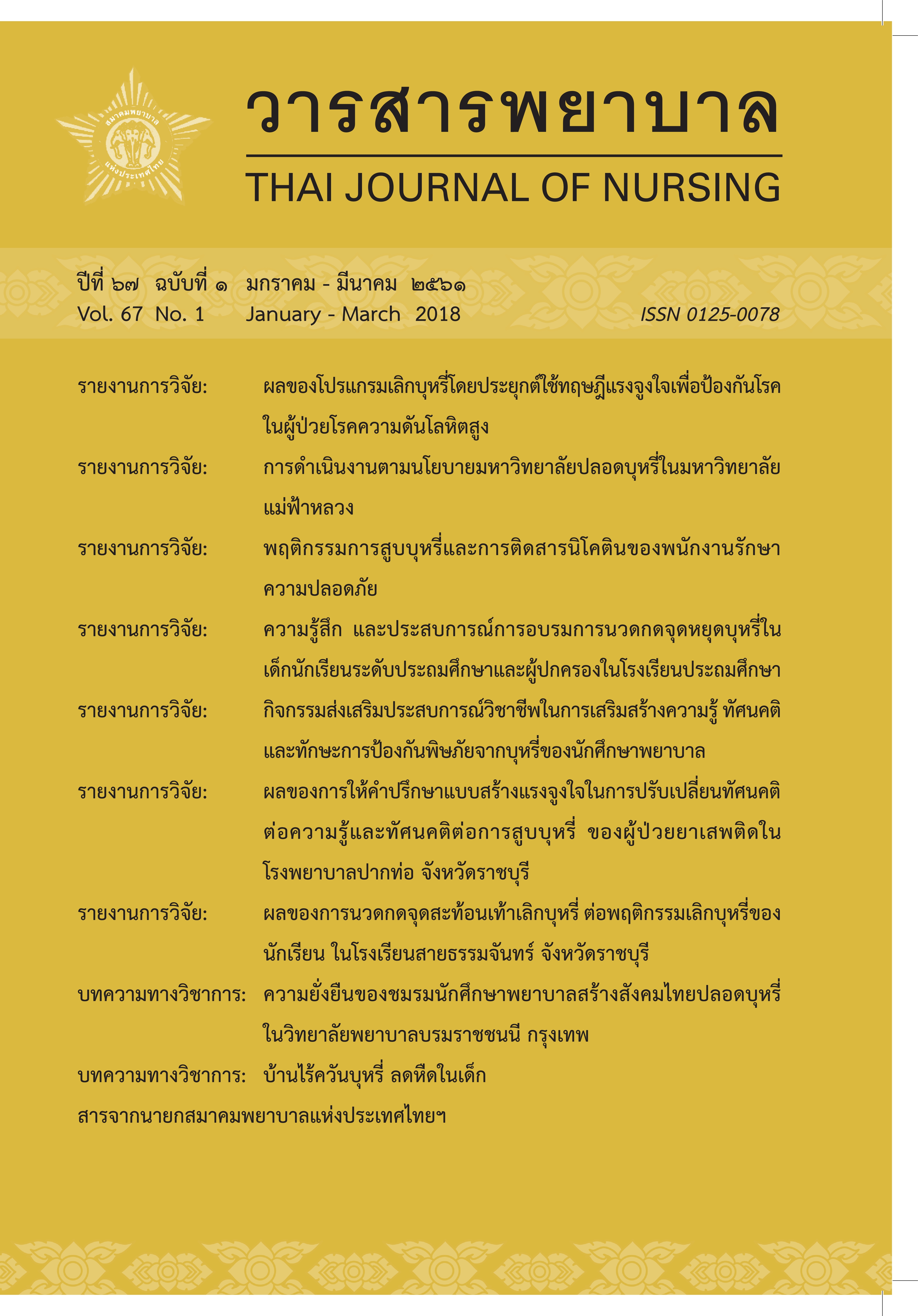The effect of smoking cessation program by applying the Protection Motivation Theory in patients with hypertension
Main Article Content
Abstract
The purpose of this quasi-experimental study aimed to examine the effect of smoking cessation program in patients with hypertension by applying Protection Motivation Theory. The samples were male smokers with hypertension receiving service at Bangnamprieo hospital, Chachoengsao province. The experimental group (n = 27) received 2 monthly sessions of a smoking cessation program with the focus on enhancing perceived severity of disease, perceived vulnerability of complications, response efficacy and self-efficacy in smoking cessation and telephone followed-up on the 3rd, 7th and 14th days after setting quit date. Comparison group (n = 26) was provided with self-help material about smoking cessation. Data were collected using questionnaire and piCO smokerlyzer at pre-test, post-test and follow-up. The research findings showed that after the intervention, the experimental group had mean score of perceived severity, perceived vulnerability of complications, response efficacy and self-efficacy significantly higher than that of the pre-test and comparison group (p < .05). In addition, the number of cigarettes smoked by the experimental group was significantly lower than the pre-test and that by the comparison group (p < .05). However, the mean score of nicotine dependence level and exhaled carbon monoxide level were not significantly different from that of the comparison group (p > .05).
Article Details
References
สงเคราะห์เด็กชาย. วิทยานิพนธ์พยาบาลศาสตรมหาบัณฑิต สาขาวิชาการพยาบาลเวชปฏิบัติชุมชน,
บัณฑิตวิทยาลัย มหาวิทยาลัยมหิดล.
บุญใจ ศรีสถิตย์นรากูร. (2553). ระเบียบวิธีการวิจัยทางการพยาบาลศาสตร์(พิมพ์ครั้งที่ 5). กรุงเทพมหานคร:
ยูแอนด์ไอ อินเตอร์มีเดียร์.
พรรณนิภา หงษ์อินทร์. (2558). ผลของโปรแกรมการสร้างแรงจูงใจเพื่อการเลิกสูบบุหรี่ในผู้ป่วยศัลยกรรมกระดูก.
วิทยานิพนธ์พยาบาลศาสตรมหาบัณฑิต สาขาวิชาพยาบาลศาสตร์, จุฬาลงกรณ์มหาวิทยาลัย.
มูลนิธิรณรงค์เพื่อการไม่สูบบุหรี่. (2560). ข้อมูลต้องรู้ การสูบบุหรี่เป็นของแสลงคนเป็นความดันโลหิตสูง.
(แผ่นพับ). กรุงเทพมหานคร: มูลนิธิรณรงค์เพื่อการไม่สูบบุหรี่.
วิชัย เอกพลากร, เยาวรัตน์ ปรปักษ์ขาม, สุรศักดิ์ ฐานีพานิชสกุล, หทัยชนก พรรคเจริญ, วราภรณ์ เสถียรนพ
เก้า และกนิษฐา ไทยกล้า. (2553). รายงานการสำรวจสุขภาพประชาชนไทยโดยการตรวจร่างกาย
ครั้งที่ 4 พ.ศ.2551-2. นนทบุรี: เดอะกราฟิโก ซิสเต็มส์.
ศรัณยพิชญ์ ปาประลิต. (2559). ผลของโปรแกรมการให้ความรู้เพื่อช่วยเลิกบุหรี่แบบกระชับร่วมกับการใช้
โทรศัพท์ติดตามผลการเลิกบุหรี่ของพนักงานอุตสาหกรรมผลิตภัณฑ์หลังคา จังหวัดสระบุรี.
วารสารพยาบาล, 65(1), 28-38.
สมพร สันติประสิทธิ์กุล, นุสรา นามเดช และปริยศ กิตติธีระศักดิ์. (2555). พิษภัยยาสูบต่อสุขภาพ.
ใน สุปาณี เสนาดิสัย และ สุรินธร กลัมพากร (บรรณาธิการ). บุหรี่กับสุขภาพ: พยาบาล
กับการควบคุมการบริโภคยาสูบ (พิมพ์ครั้งที่ 2, หน้า 79-87). กรุงเทพมหานคร: เบญจผล.
สุนารี ทะน๊ะเป็ก. (2555). โปรแกรมสุขศึกษาเพื่อส่งเสริมการเลิกบุหรี่มวนเองของผู้หญิงอำเภอแม่จัน
จังหวัดเชียงราย. วิทยานิพนธ์วิทยาศาสตรมหาบัณฑิต (สาธารณสุขศาสตร์) สาขาวิชาเอกสุขศึกษา
และพฤติกรรมศาสตร์, บัณฑิตวิทยาลัย มหาวิทยาลัยมหิดล.
Campbell, N. R., Khalsa, T., Lackland, D. T., Niebylski, M. L., Nilsson, P. M., Redburn, K. A. et al.
(2016). High blood pressure 2016: Why prevention and control are urgent and important. The
Journal of Clinical Hypertension, 18(8), 714-717.
Haustein, K-O., & Groneberg, D. (2010). Tobacco or health (2nded.). New York: Springer.
Heatherton, T. F., Kozlowski, L. T., Frecker, R. C., &Fagerstrom, K. O. (1991). The Fagerstrom Test for Nicotine Dependence: a revision of the Fagerstrom Tolerance Questionnaire. British Journal of Addiction, 86, 119-1127.
Jianvitayakij, S., Panpakdee, O., Malathum, P., Duffy, A.S., & Viwatwongkasem, C. (2014). Factors
influencing smoking cessation behavior among Thai male smokers with Hypertension. Pacific
Rim International Journal of Nursing Research, 18(2), 100-110.
piCO: Breath CO monitor to help stop smoking. Retrieved March 5, 2018, from https://www.bedfont .com/
shop/smokerlyzer/pico
Rogers, R. W. (1983). Cognitive and physiological processes in fear appeals and attitude change: A
revised theory of protection motivation. In J. Cacioppo & R. Petty(Eds.). Social psychophysiology
(pp. 153-174). New York: Guilford Press.
World Health Organization. (2016). Tobacco. Retrieved December 15, 2016, from https://www.who.int/
mediacentre/factsheets/fs339/en/


